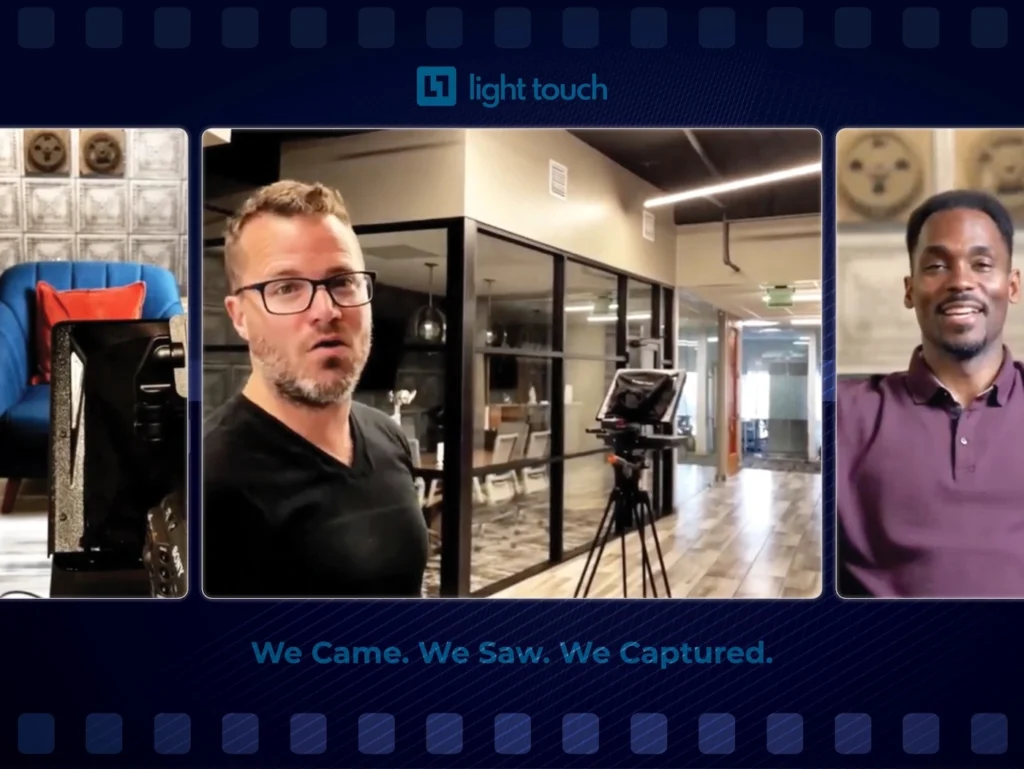“Good morning.
For whatever reason, live shoots tend to start very, very early.
There’s sort of no way around it.
Because you have to get a certain amount done during the day.
The most glamorous part of every shoot is the load-in [laughter], and we’re done with that.
We need to work out what’s going to look really great on camera.
Because something can look good, like this is a fun and really neat space, but when you’re framing your shot, you want to make sure you’re showing something that really communicates whatever it is that you need to communicate.
We want to really pay attention to our host. He’s a very charming, good guy, very talented, very good at what he does.
And we really want his communication to be front and center.
So we found what we call “leading lines” on either side, where the eye is drawn to the center of this space here.
So we’re going to initially set up here and see if we can make that work, and we’ll only really know that once we look into the camera’s viewfinder and determine, yes, this framing is good or not, does the lighting work, etc.
The lighting here as it is right now, is not going to work at all for a lot of different reasons.
There’s a lot of different colors of lighting in here that are going to conflict and contrast and make it very hard to finish the edit when we’re done.
So we’re going to manually set up lighting and make it exactly what we want it to be.
There’s two fundamental steps to making footage look great.
There’s having gear that’s good enough to technically accomplish what you want—the look and the feel and the vibe.
And then there’s knowing how to use it all.
So it’s sort of equal parts Art and Science.
You have to know technically what you’re doing fundamentally, and then you have to make a lot of creative and artistic choices to make sure that the end product is exactly what you want.
And a lot of that just comes from experience.
So, having heart attack moments on set, or getting into the editing booth and thinking “that was not what I hoped it would be,” and then learning from that and thinking about that for the next shoot.
So there’s a lot to be said for 10,000 hours of doing this for years at a time until you get really good at it.
And you’ll notice if you sort of look around the space in here and how I’m lit, it’s really dark in here.
And what’s interesting about shooting a lot of live video content is that when you look at the finished product you think it’s really beautiful and brightly light, sort of like daylight, but in reality, when you’re controlling the lighting elements, it’s not nearly as bright as you might think.
So we’re sort of sitting here in the dark getting the teleprompter software going.
Voice artist on set: “…with extreme experiences that bring the arts of networking, mixology, cooking….”
One thing you’ll notice if you look around this space, it’s just a mess, right?
But all that matters is what you see in the camera frame, and when you look in the viewfinder of the camera you can begin to get a sense of what we’re trying to capture.
But we’re not seeing—there’s a foosball table over here, etc.
But you see in the actual frame that it just ends up looking great.” – Wil Seabrook, Founder and Filmamker, Light Touch Media Group
For the full scope of our on-set and on-the-scene video services and to learn how they could help your business grow exponentially, see “Live Video.”
Or contact us for immediate service.


